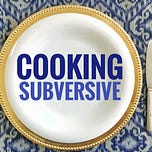#GeekingOutSeries/Safety101/KitchenDangerous/3
This post is part of the Geeking Out series which presents data-driven information on food and farming, safety in the kitchen, practical science for cooks, cooking techniques and processes and other relevant nerdy stuff that every cook should know. For the next few weeks, we will be covering topics from the chapter, Safety 101.
Read Kitchen Dangerous: part 1and part 2
In part 2 of Kitchen Dangerous, we talked about what to do when a fire occurs and how to avoid oil splatter burns from frying. In this post, we’re covering more hot stuff and first aid for burns using ingredients you probably already have at home.
More Hot Stuff
Draining pasta noodles in the sink, pouring scalding liquids into containers, removing the lid of a simmering pot, touching the metal handle of a hot skillet, removing a baked dish from the oven, handling a metal spatula left in a hot sauce pan, bumping against the handle of a hot wok and causing it to tip over—these are some of the ways you can burn yourself. But first, a few more rules.
Rule number five: Always use oven mitts or pot holders whenever you handle something hot.
Rule number six: Use tongs and long-handled cooking implements to keep your hand away from heat, such as when grilling or scooping out hot food.
Rule number seven: Avoid wearing clothing and accessories such as scarves, neckties, long necklaces or blouses with long flowing sleeves that can catch on pot handles or dip into hot liquids and food.
Rule number eight: Keep pot and skillet handles of cooking vessels on front burners turned sideways or inwards.
Pot and pan handles can easily be bumped or get caught in articles of clothing which could lead to burn splatter and spills. You also don’t want curious children grabbing exposed handles.
Rule number nine: Be familiar with some easy kitchen science that governs hot things. You’ll be able to come up with your own safety procedures when you remember some of these guidelines:
Metal is a heat conductor. That means anything metal connected to something hot—such as the handle of a skillet or saucepan lid or metal spoon left in cooking food, will also be hot. Which also means,
Don’t leave cooking implements such as ladles and spatulas in a pot or pan while cooking. If it’s metal, you may burn yourself; if it’s not metal you may also burn or melt the implement.
Hot liquids produce hot steam and hot air rises. No, this is not a facial, it can burn you. So when pouring hot liquid into containers or into the sink such as when draining pasta noodles: avert your face, be gentle and pour away from your body. Get as close as possible so you don’t splatter.
For hot food and liquid, only use containers that are graded for heat such as tempered glass, metal, bake or oven-proof ware.
Extreme temperature changes can cause containers to break such as glass or ceramic bowls, even if they are oven-proof. Before washing, make sure the vessels are allowed to cool. Conversely, putting cold food straight into a hot oven may cause containers to break.
Do not process very hot food or liquid in blenders and food processors. High temperatures plus high speed processing increase pressure and may cause blender top to pop and splatter scalding food and liquid everywhere. Allow soups or other food that’s been cooking to cool for at least 10 minutes before processing. Follow capacity limit (do not overfill), release steam by opening blender shoot, and start on low before building to desired speed.
Rule number ten: Have a first aid plan for burns. See a doctor if burns are serious.
First Aid for Burns
Kitchen burns though common are often minor, which means they are easily treatable at home. The first step is to reduce the temperature of your burn by running it under cold water. After making sure the burn surface is clean, apply topical home remedies like aloe vera, moringa, honey, broadleaf plantain (plantago major) or tomato to reduce inflammation, alleviate pain and/or minimize blistering. You can also use over-the counter burn creams or ointments.
Much anecdotal evidence exists on the efficacy of natural burn remedies. I learned about the use of aloe vera, moringa and tomatoes growing up in the Philippines, but these are common herbal remedies found in many cultures. Aloe vera as a medicinal plant was used as far back as 1500 BC in Greece and China, and many Filipino households, including my own, grew them. We also frequently had moringa and tomatoes at home because they were part of our cuisine, even before anyone realized they were superfoods with a multitude of benefits.
There’s scientific data to back the healing properties of all these home remedies for topical treatments to burns, except for tomatoes. While I have personally experienced the soothing relief of a tomato on a burn, I don’t have the studies to support it. Absence of western scientific data is not proof of ineffectiveness. Either the studies haven’t been done or I just haven’t found them yet. That’s not the case for consumption of the fruit, however. While data may be scant for topical applications, there’s lots of evidence this South American native helps with burns due to its high vitamin, nutrient and Lycopene load. Lycopene is the carotenoid responsible for the red pigment, credited with antioxidant properties, protection from infection and wound healing. Lycopene production is increased by cooking and the most concentration can be found in tomato paste.
How to use:
Honey- apply directly to burn. According to an article from the US National Library of Medicine,
“The free radical control by honey, due to its anti-oxidant effect, limits damage and subsequent multi-organ dysfunction. Honey's anti-bacterial action, low pH, high viscosity, hygroscopic effect, and its hydrogen peroxide content all play a combined role in honey's effectiveness in burns treatment. Honey provides a moist environment for optimum healing conditions.”
Though commercial wound dressings and products tend to use medical-grade Manuka honey, the report makes no distinction in efficacy among unprocessed undiluted honey from various sources.
Tomato- slice and apply directly to burn.
Broadleaf plantain and Moringa- apply as a poultice. Wash leaves, mash to make into a paste/poultice, then apply directly to burn. While it may be easier to use a pestle and mortal to mash the leaves, chewing provides maximum efficacy as saliva also stimulates wound-healing.
Aloe Vera- cut a leaf and peel to access the gelatinous surface and apply directly to burn.
My personal practice: I use all but the moringa interchangeably for burns, and only because moringa is not readily available where I live. Tomatoes, which provide immediate cooling and soothing relief can be messy to apply, so I only use it occasionally, as with honey which I’ve only used in the form of commercial wound dressings. For convenience, I often default to a home-made salve of plantain, a common plant that grows in my yard, as first aid to all skin irritants—from burns, cuts to insect bites and stings. A salve is quickly accessible and easier to apply than poultices. Broadleaf plantain, well-known to Native Americans, has tremendous medicinal properties and deserves its own future post. I also grow aloe vera in pots and simply cut a leaf and rub the gelatinous juicy side to burns, including sunburns.
This is the end of part 3 of Kitchen Dangerous. In part 4, we will cover Knives and Other Sharp Things.
Interested to learn more? Read companion posts on Cooking Subversive:
The Kitchen Dangerous series
Part 1: Liar, Liar Pans on Fire: Fire and All Things Hot
Part 2: Don’t Burn Yourself
Part 3: More Hot Stuff
Part 4: Knives and Other Sharp Things
Part 5: First Aid for Cuts (and Burns)
References:
https://www.ncbi.nlm.nih.gov/pmc/articles/PMC6330525
https://www.ncbi.nlm.nih.gov/pmc/articles/PMC3188068
https://www.ncbi.nlm.nih.gov/pmc/articles/PMC5878035
https://www.ncbi.nlm.nih.gov/pmc/articles/PMC6330525
https://pubmed.ncbi.nlm.nih.gov/11340098
https://www.ncbi.nlm.nih.gov/pmc/articles/PMC3188068
https://www.ncbi.nlm.nih.gov/pmc/articles/PMC6593997

















Share this post